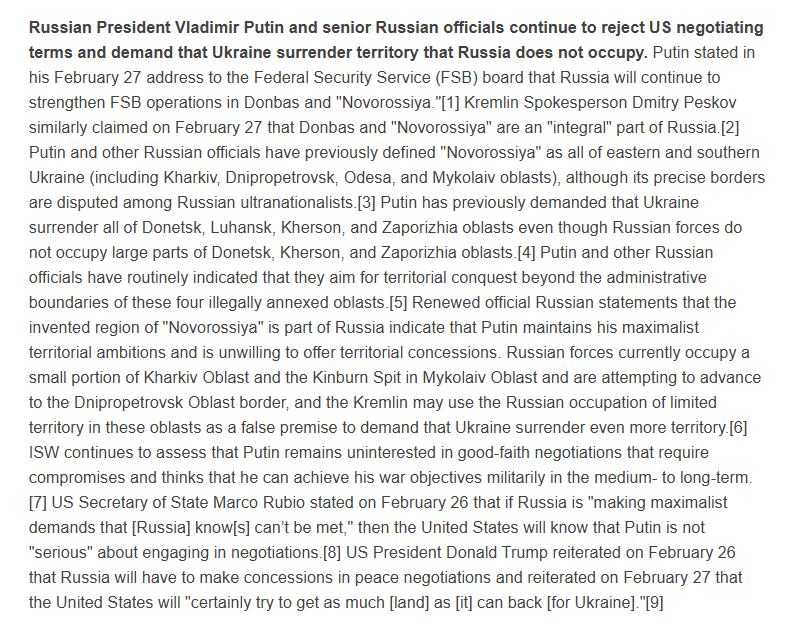NEW: US Special Envoy to the Middle East Steve Witkoff uncritically amplified a number of Russian demands, claims, and justifications regarding the war in Ukraine during an interview on March 21.
Witkoff stated that Russia "reclaimed" five regions in Ukraine — Crimea and Luhansk, Donetsk, Zaporizhia, and Kherson oblasts — and that Russia "has gotten what [it] wants" and will not want more.
The Kremlin has repeatedly and falsely claimed that Crimea and these four oblasts are Russian territory contrary to international law, and Witkoff's statement about Russia "reclaiming" these areas (which Russia has illegally occupied and annexed) amplifies the Kremlin's justifications for its expansionist territorial demands and multiple invasions of Ukraine.
MORE ⬇️
▪️ Vladislav Surkov, a former close adviser to Russian President Vladimir Putin, recently reiterated several longstanding Kremlin claims and ambitions that directly contradict Witkoff's assertions in an interview with French media aimed at Western audiences.
▪️ Surkov's statements are consistent with those made by Putin and senior Russian officials, who have recently and repeatedly stated that Russia intends to bring Ukraine under Russian control and establish suzerainty over neighboring countries in order to weaken the West and strengthen Russia's global influence.
▪️ Putin and other Russian officials have also recently reamplified Russian narratives that "Novorossiya," which Kremlin Spokesperson Dmitry Peskov has defined as all of eastern and southern Ukraine including Kharkiv, Dnipropetrovsk, Mykolaiv, and Odesa oblasts, is an "integral" part of Russia.


Witkoff stated that Russia "reclaimed" five regions in Ukraine — Crimea and Luhansk, Donetsk, Zaporizhia, and Kherson oblasts — and that Russia "has gotten what [it] wants" and will not want more.
The Kremlin has repeatedly and falsely claimed that Crimea and these four oblasts are Russian territory contrary to international law, and Witkoff's statement about Russia "reclaiming" these areas (which Russia has illegally occupied and annexed) amplifies the Kremlin's justifications for its expansionist territorial demands and multiple invasions of Ukraine.
MORE ⬇️
▪️ Vladislav Surkov, a former close adviser to Russian President Vladimir Putin, recently reiterated several longstanding Kremlin claims and ambitions that directly contradict Witkoff's assertions in an interview with French media aimed at Western audiences.
▪️ Surkov's statements are consistent with those made by Putin and senior Russian officials, who have recently and repeatedly stated that Russia intends to bring Ukraine under Russian control and establish suzerainty over neighboring countries in order to weaken the West and strengthen Russia's global influence.
▪️ Putin and other Russian officials have also recently reamplified Russian narratives that "Novorossiya," which Kremlin Spokesperson Dmitry Peskov has defined as all of eastern and southern Ukraine including Kharkiv, Dnipropetrovsk, Mykolaiv, and Odesa oblasts, is an "integral" part of Russia.



2/ Ukrainian forces recently advanced near Pokrovsk, and Russian forces recently advanced near Siversk and Pokrovsk and in western Zaporizhia Oblast.
Russian Offensive Campaign Assessment, March 22, 2025: isw.pub/UkrWar032225

Russian Offensive Campaign Assessment, March 22, 2025: isw.pub/UkrWar032225


2/ Ukrainian forces recently advanced near Pokrovsk, and Russian forces recently advanced near Siversk and Pokrovsk and in western Zaporizhia Oblast.
Russian Offensive Campaign Assessment, March 22, 2025: isw.pub/UkrWar032225

Russian Offensive Campaign Assessment, March 22, 2025: isw.pub/UkrWar032225


• • •
Missing some Tweet in this thread? You can try to
force a refresh
























